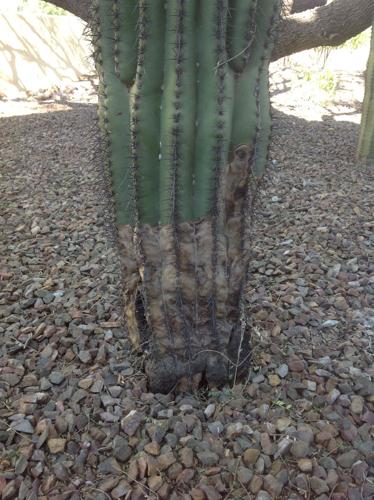Q: Can you tell me what is going on with this sage bush? I took a sample to the nursery and was told it is new growth. The bush has been this way for a couple of years and stays on the same side of the bush. Is this a problem or just new growth?
A: New growth is correct in so far as it’s newer than the shrub you planted. Unlike normal new growth, it won’t take on the appearance of old growth after a period of time. It appears that your Texas ranger has reverted back to it’s original form, at least in part.
Many of the interesting cultivars we see in landscapes originate from some mutation with desirable characteristics from the original parent plant. These interesting mutations can be propagated into new cultivars and then introduced into the horticulture trade. Unfortunately, not all of these cultivars are stable and they sometimes revert back to the original plant. The original is likely more vigorous than the designer cultivar and could take over the space by outgrowing the shrub you planted. So if you like the one you planted more than the new original version, you can prune out the offending parts. As long as we’re discussing them, these plants are commonly called sages but are actually not related to the true sages in the Salvia genus. Rather they are in the figwort family, Scrophulariaceae.
Q: What is wrong with this saguaro cactus?
A: The brown and black areas show signs of bacterial necrosis. This is a common affliction of cacti in the desert and unfortunately once it gets into the main stem and spreads that wide there is nothing you can do to fix the problem. Eventually the cactus will succumb and fall over. It would be wise to plan for that eventuality and make sure there aren’t any potential hazards such as the chance people or property could be damaged if it fell unannounced. Contracting with an experienced landscaper or certified tree professional to take it down would be appropriate if any hazards are present.
Q: We planted this Satsuma Mandarin Orange two years ago, and last spring it had good foliage and produced two or three small fruit. But now, it appears to lose leaves on lower branches, put out new leaves on upper branches, but has not gained any new branches or height. It is on a drip system. I don’t see evidence of anything chewing on it. Any suggestions on how to help out thrive?
A: This is typical for newly planted trees. The stress of transplanting sometimes causes some leaf drop and/or fruit and flower drop. Assuming you are watering and fertilizing properly, I expect you will see new growth in the coming year. Trees typically take between two and three years to get established in their new surroundings before they show a lot of growth. This is mainly due to the large amount of root damage they incur during transplanting.
Q: I have a mature Valencia orange tree that has yellowing leaves and dead end tip branches. It also has some dried yellow fruit. The tree is watered three times a week for 45 minutes each time with three bubbler type irrigation system heads at the tree drip line. Any thoughts on what may be the problem?
A: Although yellowing leaves can also indicate a lack of nitrogen, the dead end branches and your current irrigation schedule tells me the tree needs more water. If you are fertilizing three times per year as recommended in late winter, spring, and fall, the other important input is water. While your placement of bubblers is appropriate, the scheduled watering is not ideal. Citrus trees do best with deeper watering on a less frequent basis. During the summer, every 7 to 10 days to a depth of 36 inches is recommended. In the spring and fall you can back that off to every 10 to 14 days and in the winter to every 14 to 21 days.






